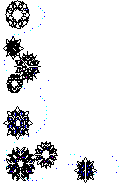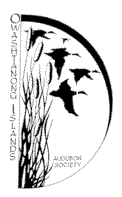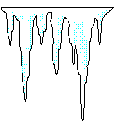Snowflakes
Judi Manning





Frozen crystals of all shapes and sizes float down and accumulate. The white fields resemble diamonds glittering in the sun. Wilson ‘Snowflake’ Bentley took over 6,000 photographs of individual flakes between the early 1880’s and his death in 1931. No two were alike.
Some snowflakes resemble Dorian columns; some look like oak leaves; some are shaped like dinner plates; and thousands are almost perfectly symmetrical six-armed intricate snowflakes that look like frozen lace.
Scientists believe dust and bacteria
blown off plants and thrown into the air by ocean waves produce rain and snow.
In a lab, Russell Schnell (U of CO) produced snowflakes by injecting bacteria
into a cloud chamber. The experimental clouds immediately turned into snow. The
bacteria, Pseudomonas syringae and Erwinia herbicola,
contain a molecule that attracts water. After one ice crystal forms, it
splinters. Each fragment serves as a seed for another ice crystal. The
snowflake’s six-sided shape comes from the hexagonal lattice structure of an ice
molecule.

Ice crystals are extremely sensitive to
a variety of conditions, including temperature, air currents, and humidity. A
crystal needs atmospheric conditions of 5°
F. to grow. These six-sided hexagonal crystals are
 shaped in the high clouds;
needle or flat six-sided crystals are shaped in the middle height clouds; and a
wide variety of six-sided shapes are formed in the low clouds. The colder the
temperature, the ice crystal tips are sharper. At warmer temperatures, the ice
crystals grow slower and smoother, resulting in less intricate shapes. The
growing branch-like protrusions are called dendrites. Differences in the
macroclimate on each side of the ice crystal produces the asymmetrical shapes.
shaped in the high clouds;
needle or flat six-sided crystals are shaped in the middle height clouds; and a
wide variety of six-sided shapes are formed in the low clouds. The colder the
temperature, the ice crystal tips are sharper. At warmer temperatures, the ice
crystals grow slower and smoother, resulting in less intricate shapes. The
growing branch-like protrusions are called dendrites. Differences in the
macroclimate on each side of the ice crystal produces the asymmetrical shapes.
- More snow falls each year in southern Canada and the northern US than
at the North Pole.
- Large snowflakes can measure up to 2" across and contain hundreds of individual crystals.
- The largest snowflake ever found was 8" by 12". It was reported to have fallen in Bratsk, Siberia in 1971.
- In Germany, frogs were once kept as pets because they croaked more loudly when air pressure fell and when bad weather was coming. They acted like primitive living barometers.
- An ice core 1,200 feet long can show what the climate was 1,400 years ago
- The lowest ever temp recorded was at Vostok, a research base in Antarctica on July 21, 1983: -128.6°F.
- The heaviest snowfall in 24 hours is 76" at Silver Lake, CO 4/15/21
- The heaviest snow storm occurred on Feb. 13-19, 1959 at Mt. Shasta Ski Bowl, CA: 189" of snow fell.
References
- Crystallizing the Truth, John Carey, National Wildlife, Dec/Jan. 1985, Pgs. 43-44
- Science Facts, Weather, An Exploration of the Forces that Drive the World’s Weather, Peter Lafferty.
Ice
Judi Manning
Ice exhibits itself as the gentle tiny frost flowers we see sparkling on a sunlit window, to towering icebergs. It can range in color from clear too as blue as the sky. Standing near a frozen lake you can occasionally hear a crack as it zips from shore to shore. Icicles have a melodious sound as they break away from their bases. Large blocks of ice falling from the house make a thudding sound of their own. Out cross-country skiing, the trees creak and groan under the weight of the ice in a gentle breeze.
The U.S. Army Corps of Regions Research and Engineering Laboratory (CRREL) is studying ice to unlock its secrets. They hope to help people better cope with wintertime and to take advantage of the world's vast frozen resources.
Water expands as it freezes and is lighter than water. Water can take three forms:
(1) Gas — heated, its molecules bump and bounce forming a vapor
(2) Liquid — cooled, its molecules move slowly and glide around one another to give liquid water its smooth flow
(3) Solid — chilled below 320F, its molecules slow even more and form ice crystalsThe amount of impurities deposited along the edges of the ice crystal form different types of ice:
Frazil ice: Surface water in a swiftly flowing stream is cooled below 0° C and forms crystals. These crystals move downstream and to quieter water, mix with warmer layers beneath it, and produce a spongy mass of crystals. They freeze into thick slabs, and are responsible for ice jams. Anchor ice: Surface ice that forms around stream bed rocks when the nights are cool enough. The ice detaches from the rocks when warmed by the sun and rise to the stream’s surface.
Snow ice: Formed by heavy snow that sinks surface ice and freezes into a white slab
Columnar ice: Long vertical crystals that are exposed when the outer layer of frozen water decays.
Icebergs: Portions of glaciers that break off and become free-floating. They may reach a height of 300-500 feet above the sea’s surface, with 90% of the iceberg below the water line. North Atlantic icebergs all come from the Great Greenland Ice Sheet and have been found 2,000 miles from their origin.
Glaciers are large sheets of compacted snow that move around the land. In 1930, Alaska’s Black Rapids Glacier moved 250 feet per day.
Seawater because of its salt content freezes at a lower temperature than fresh water. Sea ice is softer and weaker because the salt is forced out and pools in pockets.
Ice makes potholes in pavement that are put together with low budgets. Ground water freezes then expands, weakening the pavement overhead.
Unexpected cold snaps can be lethal on some species and if it interrupts migration. In unusual cold snaps, the male pheasant’s long tail feathers can freeze to the ground and the bird will starve. Fine snow blown by the wind can clog the nasal passages of quail and grouse, suffocating them. Thick ice coating berries, buds and seeds makes them inaccessible for birds to eat.
Reference
The Cold Truth About Ice, Richard Wolkomir, National Wildlife, 12/84, Pgs. 4 - 12
Copyright © 1997 Owashtanong Islands Audubon Society. All rights reserved.


